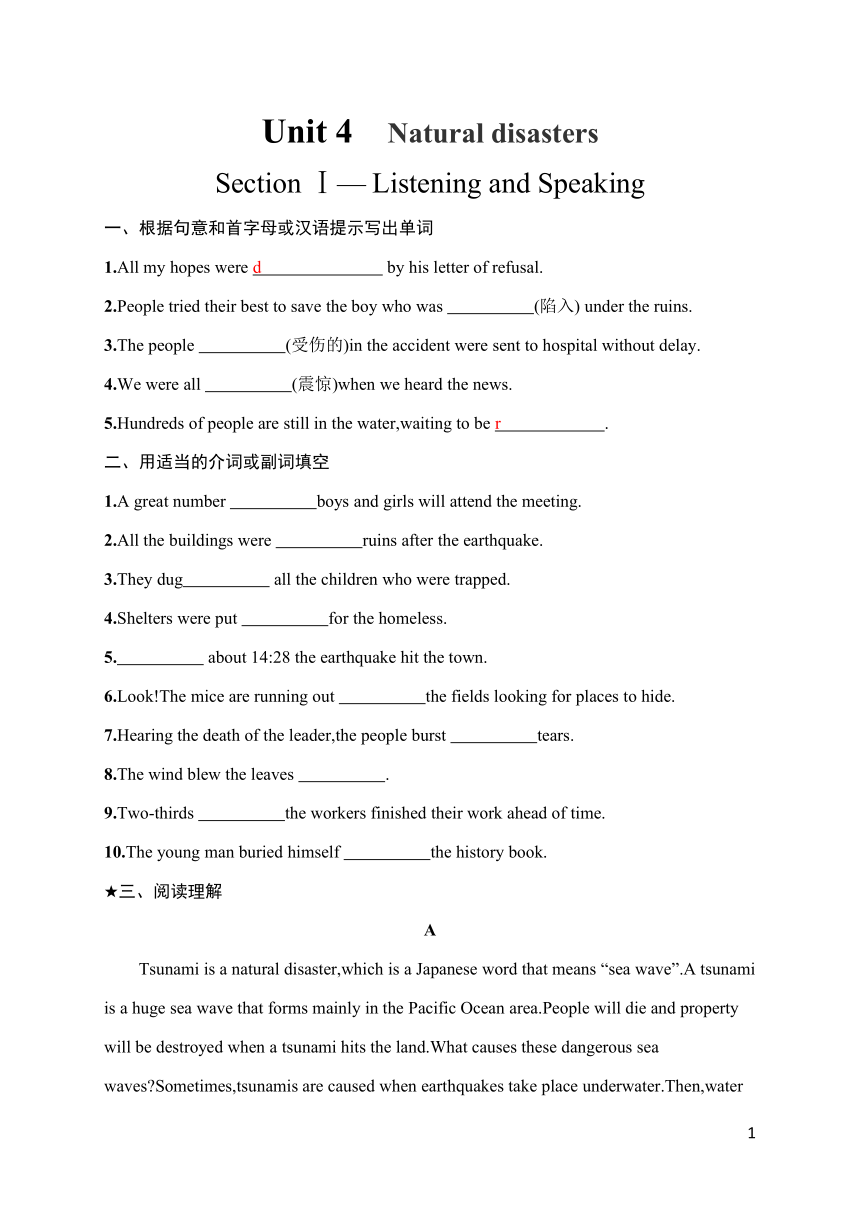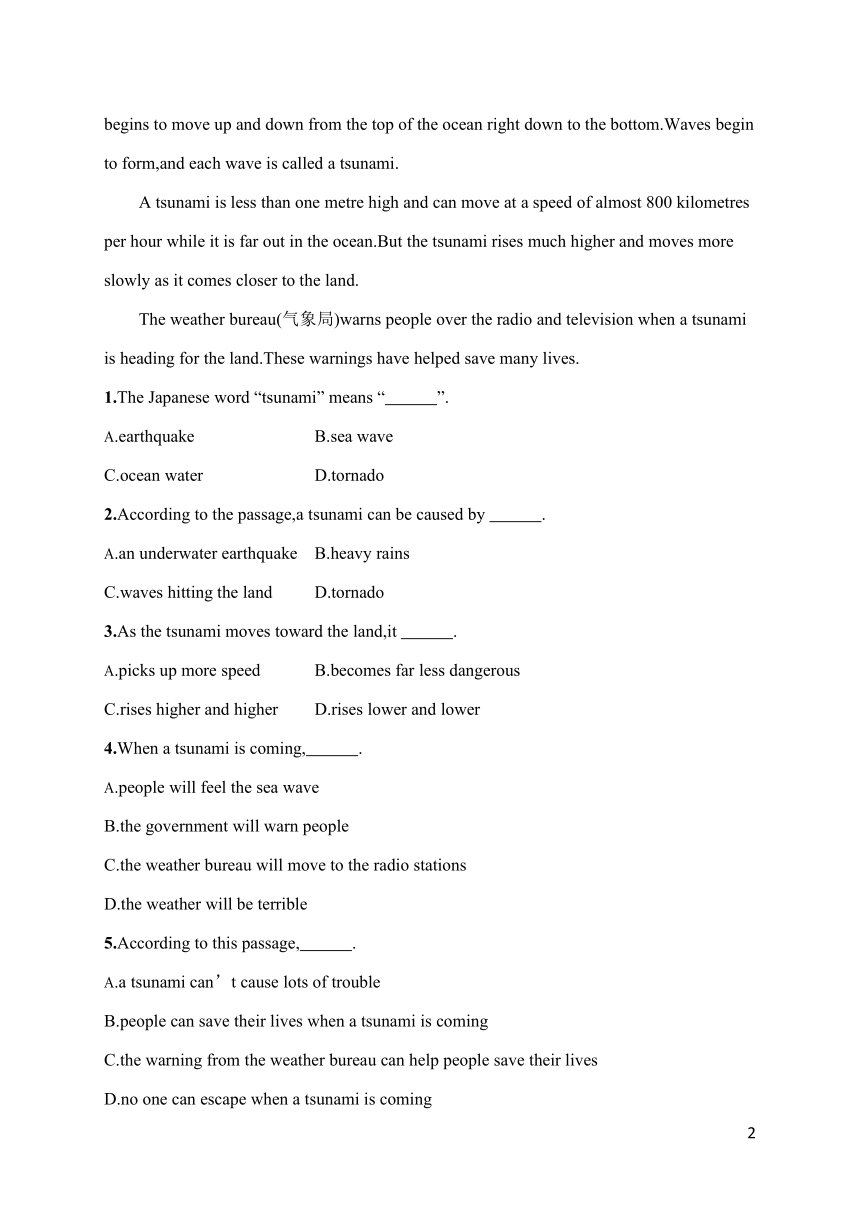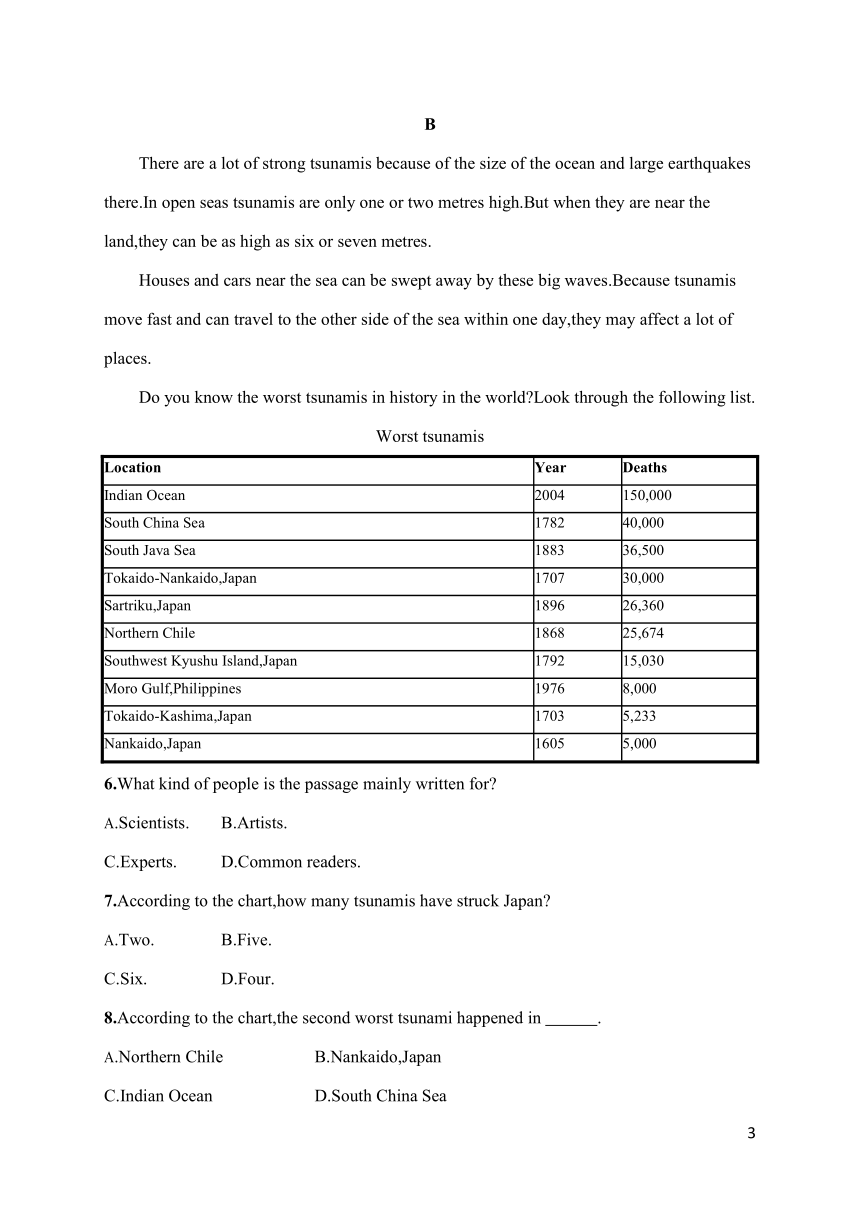人教版(2019)必修第一册Unit 4 Natural disasters Listening and Speaking同步练习(含答案)
文档属性
| 名称 | 人教版(2019)必修第一册Unit 4 Natural disasters Listening and Speaking同步练习(含答案) |  | |
| 格式 | docx | ||
| 文件大小 | 35.4KB | ||
| 资源类型 | 教案 | ||
| 版本资源 | 人教版(2019) | ||
| 科目 | 英语 | ||
| 更新时间 | 2024-04-19 20:16:41 | ||
图片预览



文档简介
Unit 4 Natural disasters
Section Ⅰ— Listening and Speaking
一、根据句意和首字母或汉语提示写出单词
1.All my hopes were d by his letter of refusal.
2.People tried their best to save the boy who was (陷入) under the ruins.
3.The people (受伤的)in the accident were sent to hospital without delay.
4.We were all (震惊)when we heard the news.
5.Hundreds of people are still in the water,waiting to be r .
二、用适当的介词或副词填空
1.A great number boys and girls will attend the meeting.
2.All the buildings were ruins after the earthquake.
3.They dug all the children who were trapped.
4.Shelters were put for the homeless.
5. about 14:28 the earthquake hit the town.
6.Look!The mice are running out the fields looking for places to hide.
7.Hearing the death of the leader,the people burst tears.
8.The wind blew the leaves .
9.Two-thirds the workers finished their work ahead of time.
10.The young man buried himself the history book.
★三、阅读理解
A
Tsunami is a natural disaster,which is a Japanese word that means “sea wave”.A tsunami is a huge sea wave that forms mainly in the Pacific Ocean area.People will die and property will be destroyed when a tsunami hits the land.What causes these dangerous sea waves Sometimes,tsunamis are caused when earthquakes take place underwater.Then,water begins to move up and down from the top of the ocean right down to the bottom.Waves begin to form,and each wave is called a tsunami.
A tsunami is less than one metre high and can move at a speed of almost 800 kilometres per hour while it is far out in the ocean.But the tsunami rises much higher and moves more slowly as it comes closer to the land.
The weather bureau(气象局)warns people over the radio and television when a tsunami is heading for the land.These warnings have helped save many lives.
1.The Japanese word “tsunami” means “ ”.
A.earthquake B.sea wave
C.ocean water D.tornado
2.According to the passage,a tsunami can be caused by .
A.an underwater earthquake B.heavy rains
C.waves hitting the land D.tornado
3.As the tsunami moves toward the land,it .
A.picks up more speed B.becomes far less dangerous
C.rises higher and higher D.rises lower and lower
4.When a tsunami is coming, .
A.people will feel the sea wave
B.the government will warn people
C.the weather bureau will move to the radio stations
D.the weather will be terrible
5.According to this passage, .
A.a tsunami can’t cause lots of trouble
B.people can save their lives when a tsunami is coming
C.the warning from the weather bureau can help people save their lives
D.no one can escape when a tsunami is coming
B
There are a lot of strong tsunamis because of the size of the ocean and large earthquakes there.In open seas tsunamis are only one or two metres high.But when they are near the land,they can be as high as six or seven metres.
Houses and cars near the sea can be swept away by these big waves.Because tsunamis move fast and can travel to the other side of the sea within one day,they may affect a lot of places.
Do you know the worst tsunamis in history in the world Look through the following list.
Worst tsunamis
Location Year Deaths
Indian Ocean 2004 150,000
South China Sea 1782 40,000
South Java Sea 1883 36,500
Tokaido-Nankaido,Japan 1707 30,000
Sartriku,Japan 1896 26,360
Northern Chile 1868 25,674
Southwest Kyushu Island,Japan 1792 15,030
Moro Gulf,Philippines 1976 8,000
Tokaido-Kashima,Japan 1703 5,233
Nankaido,Japan 1605 5,000
6.What kind of people is the passage mainly written for
A.Scientists. B.Artists.
C.Experts. D.Common readers.
7.According to the chart,how many tsunamis have struck Japan
A.Two. B.Five.
C.Six. D.Four.
8.According to the chart,the second worst tsunami happened in .
A.Northern Chile B.Nankaido,Japan
C.Indian Ocean D.South China Sea
★四、语篇填空
That morning I was playing soccer with my friends.We ran home after the strong earthquake and after that I heard a 1. (real) loud noise,like a plane.When I looked at the sea I saw something I had never seen before and I was terrified.My family 2. (rush) into our truck but the road was full of people trying 3. (escape).The black waves hit our truck,turning us over several 4.(time) before I lost consciousness(知觉).When I regained consciousness I was in the water.5.(hold) on to a school chair,I floated until I landed on 6. beach.I had no idea where I was and I was so hungry and 7. (thirst).There were bodies and pieces everywhere.Under a tree I saw a mattress (床垫) had been washed up 8. the beach and I started searching for packets of noodles and bottles of water,collecting them around my mattress.After five days I didn’t have any water or food left.I survived there by 9.(me) for 20 days.When people came to collect the bodies,they rescued me 10. took me to Fakinah Hospital where I found my father.
1.答案:destroyed
2.答案:trapped
3.答案:injured
4.答案:shocked
5.答案:rescued
1.答案:of
2.答案:in
3.答案:out
4.答案:up
5.答案:At
6.答案:of
7.答案:into
8.答案:away
9.答案:of
10.答案:in
1.答案:B
解析:细节理解题。由第一段第一句“...which is a Japanese word that means‘sea wave’.”可以得出答案。
2.答案:A
解析:细节理解题。由第一段第五句可知,水下地震可能引发海啸。
3.答案:C
解析:细节理解题。由第二段第二句可知,随着海啸离陆地越来越近,它越来越高。
4.答案:B
解析:推理判断题。由第三段可知,气象局在海啸来临时会警告人们,由此可推出答案。
5.答案:C
解析:细节理解题。由短文最后一句可以得出,气象局的警报有助于挽救人们的生命。
6.答案:D
解析:推理判断题。本文是一篇有关世界海啸灾难的应用文。从文章所介绍的知识和语气可以判断,这篇文章是写给普通读者看的。
7.答案:B
解析:细节理解题。根据表格可知与日本有关的海啸共有5次。
8.答案:D
解析:推理判断题。根据死亡人数可知第二大海啸发生在1782年的中国南海。
四、答案:1.really 2.rushed 3.to escape 4.times 5.Holding 6.a 7.thirsty 8.on 9.myself 10.and
4
Section Ⅰ— Listening and Speaking
一、根据句意和首字母或汉语提示写出单词
1.All my hopes were d by his letter of refusal.
2.People tried their best to save the boy who was (陷入) under the ruins.
3.The people (受伤的)in the accident were sent to hospital without delay.
4.We were all (震惊)when we heard the news.
5.Hundreds of people are still in the water,waiting to be r .
二、用适当的介词或副词填空
1.A great number boys and girls will attend the meeting.
2.All the buildings were ruins after the earthquake.
3.They dug all the children who were trapped.
4.Shelters were put for the homeless.
5. about 14:28 the earthquake hit the town.
6.Look!The mice are running out the fields looking for places to hide.
7.Hearing the death of the leader,the people burst tears.
8.The wind blew the leaves .
9.Two-thirds the workers finished their work ahead of time.
10.The young man buried himself the history book.
★三、阅读理解
A
Tsunami is a natural disaster,which is a Japanese word that means “sea wave”.A tsunami is a huge sea wave that forms mainly in the Pacific Ocean area.People will die and property will be destroyed when a tsunami hits the land.What causes these dangerous sea waves Sometimes,tsunamis are caused when earthquakes take place underwater.Then,water begins to move up and down from the top of the ocean right down to the bottom.Waves begin to form,and each wave is called a tsunami.
A tsunami is less than one metre high and can move at a speed of almost 800 kilometres per hour while it is far out in the ocean.But the tsunami rises much higher and moves more slowly as it comes closer to the land.
The weather bureau(气象局)warns people over the radio and television when a tsunami is heading for the land.These warnings have helped save many lives.
1.The Japanese word “tsunami” means “ ”.
A.earthquake B.sea wave
C.ocean water D.tornado
2.According to the passage,a tsunami can be caused by .
A.an underwater earthquake B.heavy rains
C.waves hitting the land D.tornado
3.As the tsunami moves toward the land,it .
A.picks up more speed B.becomes far less dangerous
C.rises higher and higher D.rises lower and lower
4.When a tsunami is coming, .
A.people will feel the sea wave
B.the government will warn people
C.the weather bureau will move to the radio stations
D.the weather will be terrible
5.According to this passage, .
A.a tsunami can’t cause lots of trouble
B.people can save their lives when a tsunami is coming
C.the warning from the weather bureau can help people save their lives
D.no one can escape when a tsunami is coming
B
There are a lot of strong tsunamis because of the size of the ocean and large earthquakes there.In open seas tsunamis are only one or two metres high.But when they are near the land,they can be as high as six or seven metres.
Houses and cars near the sea can be swept away by these big waves.Because tsunamis move fast and can travel to the other side of the sea within one day,they may affect a lot of places.
Do you know the worst tsunamis in history in the world Look through the following list.
Worst tsunamis
Location Year Deaths
Indian Ocean 2004 150,000
South China Sea 1782 40,000
South Java Sea 1883 36,500
Tokaido-Nankaido,Japan 1707 30,000
Sartriku,Japan 1896 26,360
Northern Chile 1868 25,674
Southwest Kyushu Island,Japan 1792 15,030
Moro Gulf,Philippines 1976 8,000
Tokaido-Kashima,Japan 1703 5,233
Nankaido,Japan 1605 5,000
6.What kind of people is the passage mainly written for
A.Scientists. B.Artists.
C.Experts. D.Common readers.
7.According to the chart,how many tsunamis have struck Japan
A.Two. B.Five.
C.Six. D.Four.
8.According to the chart,the second worst tsunami happened in .
A.Northern Chile B.Nankaido,Japan
C.Indian Ocean D.South China Sea
★四、语篇填空
That morning I was playing soccer with my friends.We ran home after the strong earthquake and after that I heard a 1. (real) loud noise,like a plane.When I looked at the sea I saw something I had never seen before and I was terrified.My family 2. (rush) into our truck but the road was full of people trying 3. (escape).The black waves hit our truck,turning us over several 4.(time) before I lost consciousness(知觉).When I regained consciousness I was in the water.5.(hold) on to a school chair,I floated until I landed on 6. beach.I had no idea where I was and I was so hungry and 7. (thirst).There were bodies and pieces everywhere.Under a tree I saw a mattress (床垫) had been washed up 8. the beach and I started searching for packets of noodles and bottles of water,collecting them around my mattress.After five days I didn’t have any water or food left.I survived there by 9.(me) for 20 days.When people came to collect the bodies,they rescued me 10. took me to Fakinah Hospital where I found my father.
1.答案:destroyed
2.答案:trapped
3.答案:injured
4.答案:shocked
5.答案:rescued
1.答案:of
2.答案:in
3.答案:out
4.答案:up
5.答案:At
6.答案:of
7.答案:into
8.答案:away
9.答案:of
10.答案:in
1.答案:B
解析:细节理解题。由第一段第一句“...which is a Japanese word that means‘sea wave’.”可以得出答案。
2.答案:A
解析:细节理解题。由第一段第五句可知,水下地震可能引发海啸。
3.答案:C
解析:细节理解题。由第二段第二句可知,随着海啸离陆地越来越近,它越来越高。
4.答案:B
解析:推理判断题。由第三段可知,气象局在海啸来临时会警告人们,由此可推出答案。
5.答案:C
解析:细节理解题。由短文最后一句可以得出,气象局的警报有助于挽救人们的生命。
6.答案:D
解析:推理判断题。本文是一篇有关世界海啸灾难的应用文。从文章所介绍的知识和语气可以判断,这篇文章是写给普通读者看的。
7.答案:B
解析:细节理解题。根据表格可知与日本有关的海啸共有5次。
8.答案:D
解析:推理判断题。根据死亡人数可知第二大海啸发生在1782年的中国南海。
四、答案:1.really 2.rushed 3.to escape 4.times 5.Holding 6.a 7.thirsty 8.on 9.myself 10.and
4
